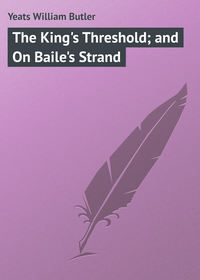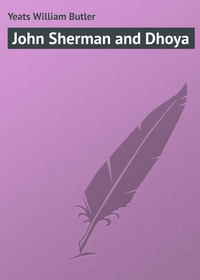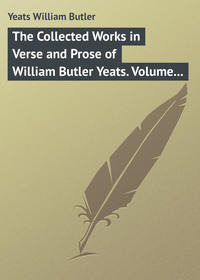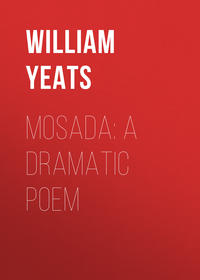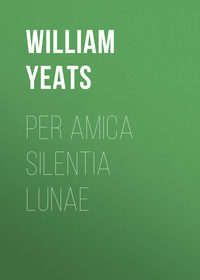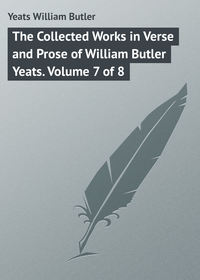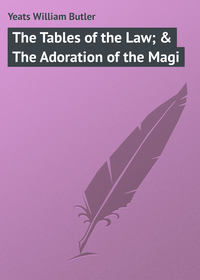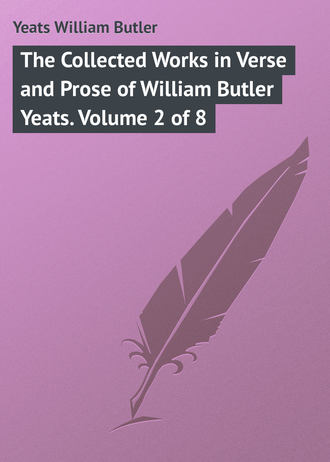 полная версия
полная версияThe Collected Works in Verse and Prose of William Butler Yeats. Volume 2 of 8
APPENDIX II.
A different Version of Deirdre’s Entrance
After the first performance of this play in the autumn of 1906, I rewrote the play up to the opening of the scene where Naisi and Deirdre play chess. The new version was played in the spring of 1907, and after that I rewrote from the entrance of Deirdre to her questioning the musicians, but felt, though despairing of setting it right, that it was still mere bones, mere dramatic logic. The principal difficulty with the form of dramatic structure I have adopted is that, unlike the loose Elizabethan form, it continually forces one by its rigour of logic away from one’s capacities, experiences, and desires, until, if one have not patience to wait for the mood, or to rewrite again and again till it comes, there is rhetoric and logic and dry circumstance where there should be life. After the version printed in the text of this book had gone to press, Mrs. Patrick Campbell came to our Abbey Theatre and, liking what she saw there, offered to come and play Deirdre among us next November, and this so stirred my imagination that the scene came right in a moment. It needs some changes in the stage directions at the beginning of the play. There is no longer need for loaf and flagon, but the women at the braziers should when the curtain rises be arraying themselves – the one holding a mirror for the other perhaps. The play then goes on unchanged till the entrance of Deirdre, when the following scene is substituted for that on pages 139-140. (Bodb is pronounced Bove.)
DEIRDRE, NAISI and FERGUS enter. DEIRDRE is carrying a little embroidered bag. She goes over towards the womenDEIRDRESilence your music, though I thank you for it;But the wind’s blown upon my hair, and IMust set the jewels on my neck and headFor one that’s coming.NAISIYour colour has all goneAs ’twere with fear, and there’s no cause for that.DEIRDREThese women have the raddle that they useTo make them brave and confident, althoughDread, toil or cold may chill the blood o’ their cheeks.You’ll help me, women. It is my husband’s willI show my trust in one that may be hereBefore the mind can call the colour up.My husband took these rubies from a kingOf Surracha that was so murderousHe seemed all glittering dragon. Now wearing themMyself wars on myself, for I myself —That do my husband’s will, yet fear to do it —Grow dragonish to myself.[The Women have gathered about her. NAISI has stood looking at her, but FERGUS leads him to the chess-tableFERGUSWe’ll play at chessTill the king come. It is but naturalThat she should fear him, for her house has beenThe hole of the badger and the den of the fox.NAISIIf I were childish and had faith in omensI’d rather not have lit on that old chessboardAt my homecoming.FERGUSThere’s a tale about it, —It has been lying there these many years, —Some wild old sorrowful tale.NAISIIt is the boardWhere Lugaidh Redstripe and that wife of hisWho had a seamew’s body half the yearPlayed at the chess upon the night they died.FERGUSI can remember now: a tale of treachery,A broken promise and a journey’s end.But it were best forgot.[DEIRDRE has been standing with the women about her. They have been helping her to put on her jewels and to put the pigment on her cheeks and arrange her hair. She has gradually grown attentive to what FERGUS is sayingNAISIIf the tale’s true, —When it was plain that they had been betrayed,They moved the men and waited for the endAs it were bedtime, and had so quiet mindsThey hardly winked their eyes when the sword flashed.FERGUSShe never could have played so, being a woman,If she had not the cold sea’s blood in her.DEIRDREI have heard the ever-living warn mankindBy changing clouds and casual accidentsOr what seem so.NAISIStood th’ ever-living there,Old Lir and Aengus from his glassy tower,And that hill-haunting Bodb to warn us hence, —Our honour is so knitted up with staying,King Conchubar’s word and Fergus’ word being pledged,I’d brave them out and stay.DEIRDRENo welcomer,And a bare house upon the journey’s end!Is that the way a king that means no wrongHonours a guest?FERGUSHe is but making readyA welcome in his house, arranging whereThe moorhen and the mallard go, and whereThe speckled heath-cock in a golden dish.DEIRDREHas he no messenger —[Etc., etc.]The play then goes on unchanged, except that on page 151, instead of the short speech of Deirdre, beginning ‘Safety and peace,’ one should read
‘Safety and peace!I had them when a child, but from that hourI have found life obscure and violent,And think that I shall find it so for ever.’APPENDIX III.
The Legendary and Mythological Foundation of the Plays
The greater number of the stories I have used, and persons I have spoken of, are in Lady Gregory’s Gods and Fighting Men and Cuchulain of Muirthemne. If my small Dublin audience for poetical drama grows to any size, whether now or at some future time, I shall owe it to these two books, masterpieces of prose, which can but make the old stories as familiar to Irishmen at any rate as are the stories of Arthur and his Knights to all readers of books. I cannot believe that it is from friendship that I weigh these books with Malory, and feel no discontent at the tally, or that it is the wish to make the substantial origin of my own art familiar, that would make me give them before all other books to young men and girls in Ireland. I wrote for the most part before they were written, but all, or all but all, is there. I took the Aengus and Edain of The Shadowy Waters from poor translations of the various Aengus stories, which, new translated by Lady Gregory, make up so much of what is most beautiful in both her books. They had, however, so completely become a part of my own thought that in 1897, when I was still working on an early version of The Shadowy Waters, I saw one night with my bodily eyes, as it seemed, two beautiful persons, who would, I believe, have answered to their names. The plot of the play itself has, however, no definite old story for its foundation, but was woven to a very great extent out of certain visionary experiences.
The foundations of Deirdre and of On Baile’s Strand are stories called respectively the ‘Fate of the Sons of Usnach’ and ‘The Son of Aoife’ in Cuchulain of Muirthemne.
The King’s Threshold is, however, founded upon a middle-Irish story of the demands of the poets at the Court of King Guaire of Gort, but I have twisted it about and revised its moral that the poet might have the best of it. It owes something to a play on the same subject by my old friend Edwin Ellis, who heard the story from me and wrote of it long ago.
APPENDIX IV.
The Dates and Places of Performance of Plays
The King’s Threshold was first played October 7th, 1903, in the Molesworth Hall, Dublin, by the Irish National Theatre Society, and with the following cast:
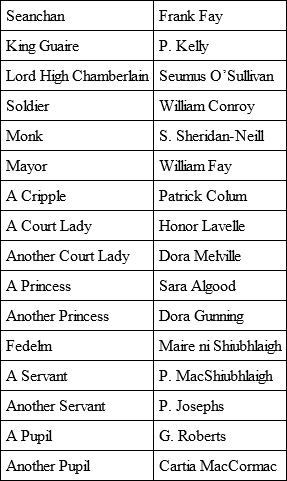
It has been revised a good many times since then, and although the play has not been changed in the radical structure, the parts of the Mayor, Servant, and Cripple are altogether new, and the rest is altered here and there. It was written when our Society was beginning its fight for the recognition of pure art in a community of which one half is buried in the practical affairs of life, and the other half in politics and a propagandist patriotism.
On Baile’s Strand was first played, in a version considerably different from the present, on December 27th, 1904, at the opening of the Abbey Theatre, Dublin, and with the following cast:

The old and young kings were played by the following: R. Nash, A. Power, U. Wright, E. Keegan, Emma Vernon, Dora Gunning, Sara Algood. It was necessary to put women into men’s parts owing to the smallness of our company at that time.
The play was revived by the National Theatre Society, Ltd., in a somewhat altered version at Oxford, Cambridge, and London a few months later. I then entirely rewrote it up to the entrance of the Young Man, and changed it a good deal from that on to the end, and this new version was played at the Abbey Theatre for the first time in April, 1906.
The first version of The Shadowy Waters was first performed on January 14th, 1904, in the Molesworth Hall, Dublin, with the following players in the principal parts:

Its production was an accident, for in the first instance I had given it to the company that they might have some practice in the speaking of my sort of blank verse until I had a better play finished. It played badly enough from the point of view of any ordinary playgoer, but pleased many of my friends; and as I had been in America when it was played, I got it played again privately, and gave it to Miss Farr for a Theosophical Convention, that I might discover how to make a better play of it. I then completely rewrote it in the form that it has in the text of this book, but this version had once again to be condensed and altered for its production in Dublin, 1906. Mr. Sinclair took the part of Aibric, and Miss Darragh that of Dectora, while Mr. Frank Fay was Forgael as before. It owed a considerable portion of what success it met with both in its new and old form to a successful colour scheme and to dreamy movements and intonations on the part of the players. The scenery for its performance in 1906 was designed by Mr. Robert Gregory.
Deirdre was first played at the Abbey Theatre, Dublin, on November 27th, 1906, with Miss Darragh as Deirdre, Mr. Frank Fay as Naisi, Mr. Sinclair as Fergus, Mr. Kerrigan as Conchubar, and Miss Sara Algood, Miss McNeill, and Miss O’Dempsey as the Musicians. The scenery was by Mr. Robert Gregory.




